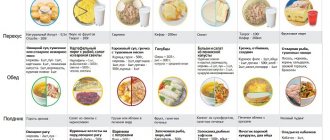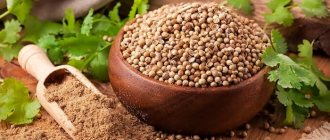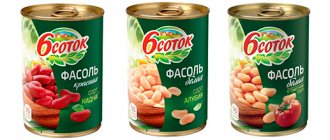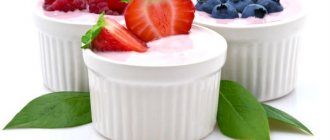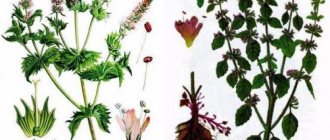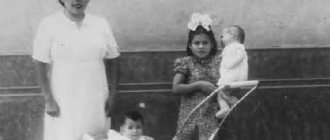To provide a newborn baby with all the necessary vitamins, during breastfeeding the young mother’s diet must be complete and nutritious. Proper nutrition will have a beneficial effect on both the composition of milk and the woman’s health. Before the start of the lactation period, you should familiarize yourself with information about what soups a nursing mother can eat.
An important point is the fact that during lactation it is better for a woman to limit or minimize the consumption of several ingredients included in soups.
Nutrition for a nursing mother: do's and don'ts
Since our article will focus on soups, we will talk specifically about those products that are included in their composition. Some vegetables should be completely excluded from the diet during breastfeeding, but there are also some that can be consumed, but not before a certain age of the baby.
So, foods that nursing mothers should not eat, especially in the first month of lactation:
- cabbage, regardless of whether it is fresh or pickled;
- eggs;
- tomatoes;
- onion;
- radish;
- garlic;
- mushrooms;
- mayonnaise;
- ketchup;
- tomato or tomato paste;
- beans;
- peas;
- sorrel;
- spices, herbs;
- carrot;
- alcohol (this point applies to those soups that are prepared on the basis of kvass, for example, classic okroshka. The drink contains alcohol, which is extremely undesirable for the mother and her baby).
Also, you should not eat borscht, kharcho soup, or soups with fatty fish or meat broth while breastfeeding. It is also better not to put overly fried vegetables in the soup: you either boil them or lightly simmer them under a closed lid in a minimum amount of vegetable oil, but just do not fry them.
It is not recommended to include sausages, sausages, smoked meats and pickled foods in soups. Everything should be natural, fresh, without the slightest sign of spoilage.
It is worth knowing that soups should absolutely not be eaten hot. Hot food is difficult for the baby's stomach to digest, so it will be better if you serve it moderately warm.
Cold soups are also not appropriate in the diet of a nursing mother; their benefits are significantly lower than a warm dish.
Historical reference
It is believed that the birthplace of green beans is South America, but today this vegetable grows all over the world. People have long used these beans not only for food, but also to create natural cosmetics, such as vegetable masks or powder.
Bean seeds contain copper, sulfur, iron, and zinc.
Eating legumes, as well as other previously unused foods, is acceptable:
- if a person follows the rules for introducing into the diet;
- if there is no allergic reaction in both mother and baby;
- if the product is properly thermally processed.
Features of nutrition of a nursing mother in the first month of feeding
The first month of a baby’s life is an incredibly important stage in its formation and development, so a young mother should be very attentive to what she eats. During this period, the newborn is very vulnerable and any new product eaten by the mother can cause colic, tummy pain, indigestion, allergies and even poisoning in the baby.
That is why, immediately after childbirth, for the first 7-10 days it is recommended to consume only light broths prepared exclusively on the basis of vegetables (not counting those described above), without adding any other ingredients (meat, fish, etc.).
After two weeks, you can try to prepare soup for breastfeeding, including potatoes, cauliflower, herbs (parsley, dill, spinach, asparagus, broccoli), and young zucchini.
Try not to put everything at once: if your baby is allergic to any ingredient, it will be difficult for you to determine which vegetable provoked such a reaction.
Add very little salt to the soup just to diversify the bland taste. As for cooking fish and meat, this also has its own characteristics. As we said above: the broth should be low-fat, therefore, after every 3 minutes of cooking, drain the liquid and add new one. Low-calorie meat should be used; chicken, rabbit, lean beef or turkey are suitable.
Onions and garlic should be introduced into the diet no earlier than 5-6 months. It is better to completely avoid mushroom soup (and mushrooms in general) during breastfeeding.
To make the dish easier for the mother and child to digest, prepare puree soups. They are softer in consistency and easier to digest by the stomach without overloading it.
Harm
Despite many beneficial properties, beans should not be consumed in such cases.
:
- if a woman’s body does not digest the polysaccharides contained in beans well, which can lead to increased gas formation and bloating;
- those suffering from nephritis or gout;
- women with gastritis, colitis, cholecystitis, pancreatitis;
- for gastric ulcers.
Beans are also dangerous for infants because they can lead to gas formation and colic in the tummy.
Recipe for pureed vegetable soup for nursing mothers
Vegetable puree soup with chicken breast turns out very tender and tasty. This simple combination of ingredients results in a nutritious, healthy dish that is easily digested in the stomach, but at the same time saturates the body with all the necessary minerals and vitamins.
These light vegetable soups are ideal for women feeding their children in the first months of their life.
Ingredients
- Chicken breast – 1 pc.;
- Green onions – 1 stalk;
- Salt - to taste;
- Water – 2 l;
- Zucchini – 1 pc.;
- Potatoes – 3 pcs.;
- Carrots – 1 pc. medium size (put it if the child is not allergic to it);
- Onions – 1 pc.
How to prepare vegetable puree soup during lactation
- Cook broth from lean chicken meat.
- Then remove the chicken from the water and transfer it to a plate.
- Strain the broth and bring to a boil again.
- Place chopped vegetables into the boiling broth: onions, carrots, potatoes, zucchini.
- As soon as the food is cooked and softened, remove the container from the heat and add the previously cooked meat to the pan.
- Gently whisk all the ingredients in the soup with a blender, bring it to a boil again, and then turn off the stove.
- Since you cannot add spices, finely chop 1-2 green onions and sprinkle them on the puree, this will be enough for a slight piquancy and beauty of the dish.
How to choose
Going to the store is one of the important stages, because you need to be confident in the quality of the purchased beans.
- First you need to carefully check its appearance. Good beans have a uniform light green hue, the bean is not loose, and juice appears on the cut.
- Avoid wilted or wet pods. This indicates poor quality storage of beans. In this case, the vegetable quickly deteriorates, brown spots appear, and its beneficial properties are lost.
Wanting to save time, many people try to replace fresh beans with canned ones. This is an absolutely wrong decision, since such beans have restrictions on their use.
Canned beans should not be consumed if:
- there is an ulcer, disruption of the functioning of the digestive tract, gout, malfunction of the gallbladder and liver;
- the baby is overly sensitive to legumes - in this case, beans need to be introduced into the diet even more carefully than fresh ones;
- Experts do not allow them during breastfeeding, considering the place in which the beans were grown and harvested to not meet the standards of healthy nutrition for the baby, and therefore their use is risky for the health of the mother and her child.
The cost of the product is quite affordable. You can buy a bag of frozen beans in almost every store. In summer, of course, it is preferable to buy fresh vegetables. Markets and vegetable pavilions provide a huge selection.
How to make beef broth with buckwheat: soup recipe for feeding
Ingredients
- Beef – 500 g + –
- Potatoes - 3 pcs. + —
- Purified water – 2 l + –
- Salt - to taste + -
- Buckwheat – 100 g + –
- Greens - to taste + -
- Carrots - 1 pc. + —
- Vegetable oil - 1-2 tbsp. + —
Add everything
to the shopping list
Remove everything
from the shopping list Shopping list
Making soup with beef and buckwheat: a simple recipe
The diet of a nursing mother should be varied, therefore, in addition to vegetables, it should include meat. Beef is most often used (remember that it should be lean), but you can use other low-calorie varieties or even combine them (as is done when preparing meatballs for soup).
In combination with buckwheat porridge and vegetables, beef soup for nursing mothers will be nourishing, tasty and light.
- Cut the beef into small pieces, add water and leave for half an hour or 40 minutes.
- After the specified time, drain the water, pour in a new portion and put the pan with the meat contents on the fire to cook until done.
- When the broth boils, salt it to taste (but do not add too much salt) and cook for two hours.
- Afterwards, we take the meat out of the pan, strain the broth and put it back on medium heat.
- Finely chop the carrots and simmer them in a frying pan in a small amount of vegetable oil. If the child is already 3 months old, then you can stew the carrots with a minimum amount of onions.
- Pour the stewed vegetables along with raw, medium-sized potatoes into the broth.
- We wash the buckwheat and also pour it into a pan with beef broth.
- When the broth with vegetables boils, let it simmer for 10 minutes.
- Then the soup should brew a little, after which we add chopped herbs and finely chopped meat.
Advantages
The nutritional characteristics of green beans are explained by its exceptional composition of substances: amino acids, carotene, fluorine, magnesium, iodine, manganese, iron, vitamins A, B, C, E and others. Compared to white and red beans, this vegetable is less rich in proteins, although here they are much easier to absorb by the body, but it benefits in terms of vitamin and mineral content.
Thanks to this composition, a number of positive phenomena occur in the body.
- The human body remains in good shape, the condition of the skin, nails and hair improves.
- Magnesium improves the stable functioning of the cardiovascular system, eliminates anemia and convulsions.
- Iron prevents anemia. One serving of beans is enough to cover the daily requirement of iron needed by the body.
- The low fat composition does not harm the figure (calorie content is approximately 30 kcal per 100 g) and does not harm the baby’s digestion.
- Fiber helps promote positive bowel function and removes toxins from the body.
Green beans fit perfectly into a diabetic's diet. The plant has a beneficial effect on body weight, since, despite its low calorie content, it leaves a lasting feeling of fullness. The vegetable perfectly restores a woman’s hormonal levels, especially after childbirth. The plant has a diuretic and calming effect, restores energy.
Another advantage of green beans is that they do not accumulate toxins from the everyday environment, so they are indispensable for nursing mothers and pregnant women, as well as for babies at the beginning of their life.
Fish puree soup from pollock with vegetables
Soups for nursing mothers should be varied so that their body receives all the vitamins necessary for the production of breast milk. These same vitamins will then be passed on to the baby during feeding.
Low-fat, non-allergenic fish is a very healthy natural product that must be present in the diet of a new mother.
It can be used on its own, or added to fish soup or pureed fish soup. It is the latter submission option that we will consider in more detail.
Ingredients
- Water – 1.5-2 l;
- Onions – 1 pc.;
- Pollock (or hake) – 1 pc. small size;
- Dill greens - to taste;
- Carrots – 1 pc.;
- Potatoes – 200-250 g;
- Pearl barley – 1 tbsp;
- Bay leaf – 1-2 pcs.
How to make fish soup for a nursing mother
- Place the fish in water and cook for 3 minutes without adding vegetables.
- After 3 minutes, drain the broth and clean the fish. After pre-cooking the fish will be easier to clean.
- Pour pearl barley, medium-sized vegetables into clean water (not counting potatoes, boil them whole and then turn them into puree), and 3 minutes before the end of cooking, add bay leaf.
- After cooking for three minutes, remove the bay leaf and turn the soup into a puree using a blender.
- Decorate the puree soup with chopped dill, cool slightly - and you can try it.
As you can see, the seemingly limited, at first glance, nursing menu can be very diverse. After reading our article, you were probably able to find for yourself not only interesting simple recipes on how to prepare delicious soups for nursing mothers, but also understood which soups in general are suitable for a nursing mother, and which ones are better not to cook during breastfeeding.
Use our proven tips - and enjoy the wonderful stage that fate bestows on every woman - motherhood!
Beneficial properties of beans
Beans, due to their high protein content, are considered the most useful analogue of meat. This representative of legumes helps strengthen the general condition of the mother, increases immunity and resistance to viruses during lactation, improves the condition of teeth and bone skeleton, saturates cells with oxygen, has a mild diuretic effect, normalizes the functioning of the gastrointestinal tract, excretory tract, and heart.
- fiber;
- carotene;
- vitamin C and ascorbic acid;
- vitamins K and B;
- microelements: calcium, magnesium, sodium, zinc;
- acids: lysine, tyrosine, arginine. tyrosine, histidine, arginine, lysine.
Canned beans
Still, if your choice fell on canned beans, here is a short list of which can is best to choose.
- Beans in clear jars work best. They may cost more, but this way you can inspect the contents.
- Don't forget about production time and shelf life. The presence of tomato paste in canned beans reduces the period.
- If there is sediment at the bottom of the jar, this means that the quality of the product is unsatisfactory.
- It is prohibited to purchase beans in metal packaging if its bottom or lid is swollen. Their presence is evidence of deterioration of the goods.
- The vegetable can remain in the refrigerator for no longer than 3 days after opening.
Method of cooking legumes
High-quality food preparation during lactation is extremely important. Green beans are subjected to all types of processing: boiled, stewed, baked, added to soups and salads.
But doctors do not advise eating the plant fresh during breastfeeding, because without heat treatment it can cause intoxication. At the same time, while a mother is feeding her baby, it is better to avoid fried foods to avoid overloading the liver.
Advice. It is worth holding off on eating raw beans (not earlier than 4-5 months after the birth of the child). Such beans are richer in fiber than processed ones, therefore, the percentage of illness in an infant is much higher. The baby will be able to digest heavier foods without negative consequences by six months from the date of birth.
Any pickles and marinades are unacceptable while feeding a baby. Beans are an excellent meat substitute for vegetarians. It is delicious, and there are a great many recipes for its preparation.
There are several simple bean dishes.

